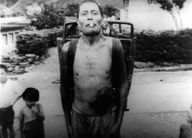The NDU and Taiwanese
All of the prints of NDU’s Asia is One, which was shot on location in Okinawa and Taiwan, were missing until recently. As a result of a search motivated by this film festival, the negatives were found and it was immediately transferred to video using the latest telecine technology. The more recent work Headhunter’s Song, which should be considered a sequel to this film, is an ethnographic music documentary by NDU member Inoue Osamu that follows the Tayal tribe member Kao Chin Su-mei.
Asia is One
(“Ajia wa hitotsu”)- JAPAN / 1973 / Japanese / B&W / Video (Original: 16mm) / 108 min
Production: NDU
Source: NDU, Planet Bibliothèque de Cinéma
 This film, which begins with the Japanese national anthem “Kimigayo,” portrays Taiwanese laborers on the main island of Okinawa, middle school students working en masse in the Sakishima Islands, and the history of coal miners on Iriomote during the Showa period (1925–1989). Moving from Yonaguni in the Yaeyama Islands to Taiwan, the film goes to a Tayal village, in which wartime conditions have not changed since the anti-Japanese uprising known as the Musha Incident (1930), and where the noontime bell was replaced by the Japanese naval anthem “Umi yukaba.”
This film, which begins with the Japanese national anthem “Kimigayo,” portrays Taiwanese laborers on the main island of Okinawa, middle school students working en masse in the Sakishima Islands, and the history of coal miners on Iriomote during the Showa period (1925–1989). Moving from Yonaguni in the Yaeyama Islands to Taiwan, the film goes to a Tayal village, in which wartime conditions have not changed since the anti-Japanese uprising known as the Musha Incident (1930), and where the noontime bell was replaced by the Japanese naval anthem “Umi yukaba.”
Headhunter’s Song: The Cry of the Aboriginal People of Taiwan
(“Shusso no uta: Taiwan genjuminzoku no tokkan, Peishang-Ituan”) JAPAN / 2005 / Japanese / Color / Video / 92 min
JAPAN / 2005 / Japanese / Color / Video / 92 min
Photography, Editing: Inoue Osamu (NDU)
Planning, Production: NDU
Production Company: Joho Kobo SPIRITON
Source: NDU
Kao Chin Su-mei, a former actress and now a legislator in the Taiwan Legislative Yuan (the legislative assembly), is from the Tayal tribe, one of the aboriginal peoples of Taiwan. Together with both the Taiwan Aborigine Workgroup, consisting of all the tribes including the Han people, and the aboriginal music group Feijuyuenbao Synectics, she finds the courage to fight for the return of their ancestors’ souls from Japan. Their appeal is unambiguous: “We cannot bear it that our ancestors’ souls are still in Japan. This is because we are not Japanese.”
